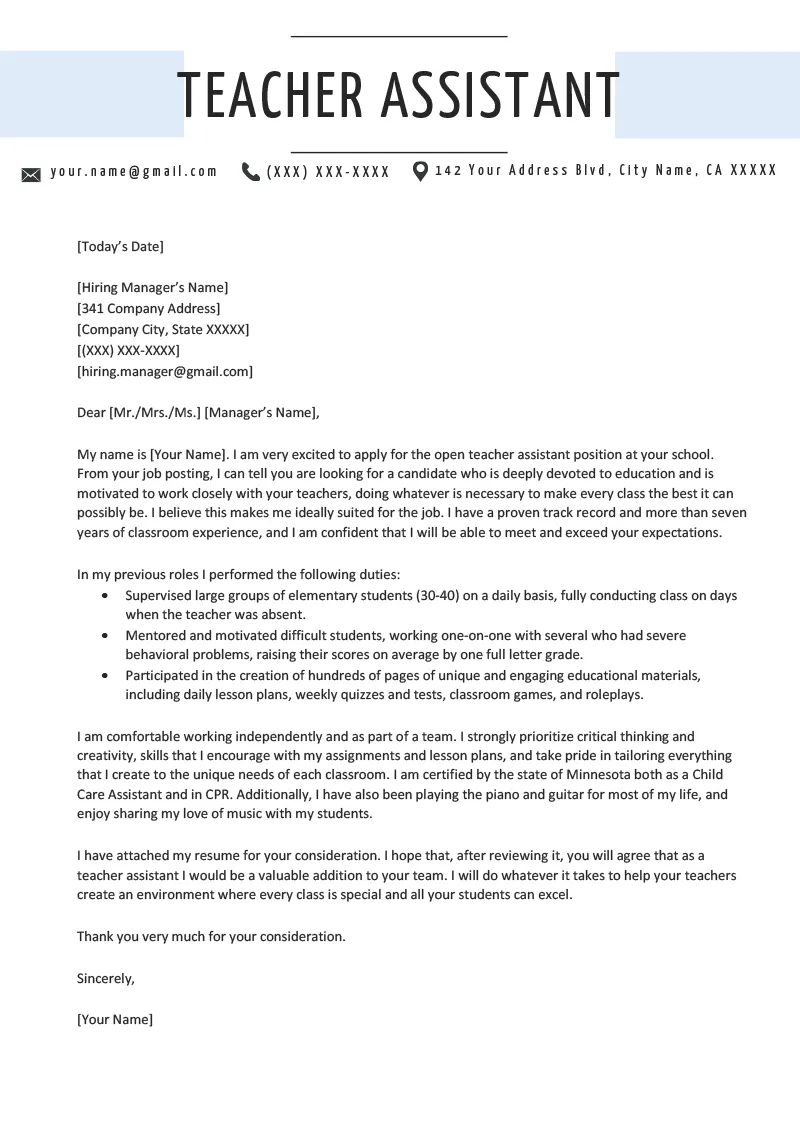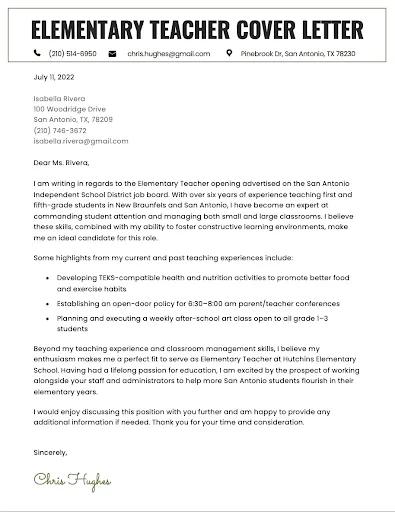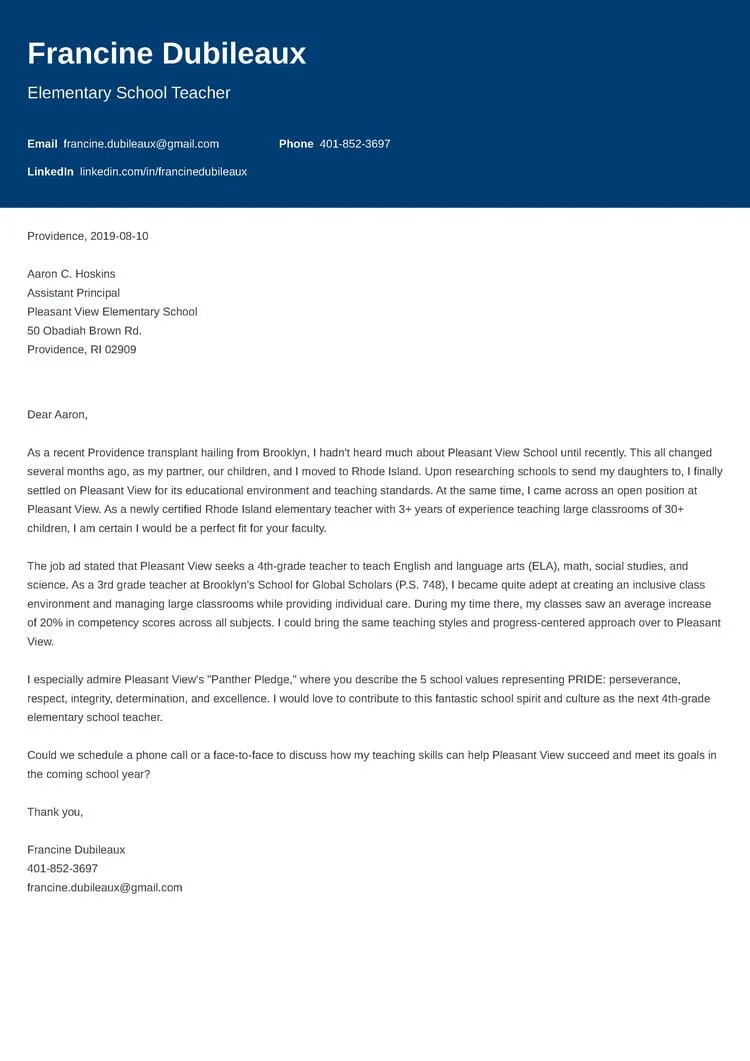Understanding the Teacher Cover Letter
A teacher cover letter is more than just a formality; it’s your first introduction to a potential employer, a chance to showcase your personality and passion for teaching. It complements your resume, providing context and depth to your qualifications. This guide delves into the essential components of a compelling cover letter, offering practical tips and examples to help you stand out from the competition and secure your dream teaching position. A well-crafted cover letter allows you to articulate your teaching philosophy, highlight relevant experiences, and demonstrate your understanding of the school’s specific needs. It is an opportunity to make a strong first impression and convince the hiring committee that you are the perfect fit for their school.
Why is a Cover Letter Important?
In a competitive job market, a cover letter provides a unique platform to differentiate yourself. It’s an opportunity to personalize your application and demonstrate your genuine interest in the specific role and school. Resumes offer a snapshot of your experience; cover letters provide the narrative. They allow you to connect your skills and experiences to the specific requirements of the job, showing how you can contribute to the school’s mission and values. Without a cover letter, you might miss the chance to elaborate on certain achievements, share your teaching philosophy, or even address any potential gaps in your resume. A well-written cover letter can be the deciding factor in whether you get an interview, especially when applying for a teaching position. Moreover, a cover letter demonstrates your communication skills, a crucial trait for teachers.
Highlighting Key Skills and Experiences

Your cover letter should directly address the skills and experiences outlined in the job description. Carefully review the requirements and tailor your letter to emphasize the qualifications that align with what the school is seeking. Consider incorporating keywords from the job posting to help your application get noticed by applicant tracking systems (ATS). Beyond listing your qualifications, provide specific examples of how you’ve demonstrated these skills in previous roles. Did you implement a successful classroom management strategy? Did you develop a new curriculum that improved student outcomes? Quantify your achievements whenever possible. For example, instead of saying you improved student test scores, state by how much, like ‘increased student test scores by 15%’. This level of detail strengthens your claims and provides concrete evidence of your abilities.
Tailoring Your Letter to the Job
Generic cover letters are easily spotted and often discarded. A tailored cover letter demonstrates that you’ve invested the time and effort to understand the specific requirements of the position and the school’s culture. Start by thoroughly reading the job description. Identify the key skills, experiences, and qualities the employer is looking for. Then, structure your cover letter to address these points directly. Mention the school’s name, and if possible, reference specific programs, initiatives, or values that resonate with you. This personalization shows that you are genuinely interested in the opportunity and have taken the initiative to learn more about the school. The more personalized your letter, the higher the chances are of getting an interview and showing you are genuinely interested in working there.
Researching the School and Its Needs
Before writing your cover letter, take the time to research the school. Visit the school’s website to learn about its mission, vision, values, and academic programs. Explore any recent news articles, social media posts, or parent testimonials to get a sense of the school’s culture and priorities. Does the school emphasize technology integration, project-based learning, or a specific pedagogical approach? Understanding the school’s needs allows you to tailor your cover letter to demonstrate how your skills and experience align with their goals. Mentioning specific programs or initiatives can show that you are interested in the school and have taken the time to understand their unique characteristics. This research will also provide valuable information you can use in your interview if you are called for one.
Crafting a Compelling Opening

The opening paragraph is your chance to grab the reader’s attention. Avoid generic greetings. Instead, start with a strong statement that immediately conveys your enthusiasm for the position. Consider mentioning how you learned about the job and why you are excited about the opportunity. If someone referred you, mention that as well. Briefly introduce yourself and highlight your key qualifications, focusing on what makes you stand out. The goal is to create an engaging introduction that encourages the reader to continue reading. For example, you could start with a compelling statement about your passion for education or your success in a previous role. The opening should be clear, concise, and tailored to the specific job and school.
Showcasing Your Teaching Philosophy
Your teaching philosophy is a critical component of your cover letter. It provides insight into your approach to education, your values, and your beliefs about student learning. Clearly articulate your teaching philosophy, highlighting your pedagogical approach, classroom management techniques, and your commitment to student success. Explain how you create a positive and inclusive learning environment, foster student engagement, and differentiate instruction to meet the diverse needs of all learners. Your teaching philosophy should align with the school’s values and mission. If the school emphasizes a specific teaching method, such as project-based learning, be sure to mention how your teaching philosophy embraces this approach. Be passionate and genuine in your writing, allowing your personality to shine through.
Demonstrating Classroom Management Skills
Classroom management is a crucial skill for any teacher. Your cover letter is an opportunity to showcase your ability to create a positive and productive learning environment. Describe your strategies for managing student behavior, promoting student engagement, and establishing clear expectations. Explain how you foster a respectful and inclusive classroom where all students feel safe and supported. Provide specific examples of how you have successfully managed challenging behaviors in the past, such as using positive reinforcement techniques, restorative justice practices, or implementing structured routines. If you have experience with specific classroom management models, such as the Responsive Classroom approach, mention them. Highlight your ability to build positive relationships with students, parents, and colleagues.
Highlighting Relevant Experience

Focus on the teaching experiences that are most relevant to the job description. Whether you’re a recent graduate or an experienced educator, highlight your accomplishments and responsibilities in previous teaching roles. Mention any specific programs, curriculum development, or projects you’ve been involved in. Quantify your achievements whenever possible. Instead of simply stating that you improved student outcomes, provide concrete data to support your claims. Include details about the grade levels you’ve taught, the subjects you’re comfortable with, and any specializations or certifications you hold. If you’ve worked with diverse student populations, mention it and describe how you’ve adapted your teaching methods to meet their needs. Be sure to tailor the examples to the specific job requirements, and provide information about what you did and why it was successful.
Quantifying Achievements with Data
Numbers speak volumes. Whenever possible, quantify your achievements with data to demonstrate the impact of your teaching. Instead of saying you improved student performance, state by how much. For example, ‘Increased student test scores by 15% in one year’. Did you implement a new classroom management strategy that led to a decrease in disciplinary referrals? Provide the percentage decrease. Did you develop a curriculum that resulted in higher student engagement? Share statistics on student participation and project completion rates. Quantifying your achievements adds credibility to your claims and provides concrete evidence of your abilities. Using data also allows you to show that you are results-oriented and that you have a data-driven approach to teaching.
Formatting and Design Tips
Your cover letter should be easy to read and visually appealing. Use a professional font, such as Times New Roman, Arial, or Calibri, and keep the font size between 10 and 12 points. Use clear headings, bullet points, and white space to break up the text and make it more readable. Make sure your letter is well-organized, with clear paragraphs that address each of the key points. Proofread your cover letter carefully for any grammatical errors, typos, and inconsistencies. The format of your cover letter should match the professional standard. Consider using a simple and clean design that is easy to read and that highlights the key information. Use a professional email address and be sure to save your cover letter and resume with the correct file name. Also, use a consistent format across all your application materials.
Proofreading and Editing for Perfection

Before submitting your cover letter, proofread it carefully to ensure it is free of any errors. Typos and grammatical errors can create a negative impression and undermine your credibility. Ask a friend, family member, or career counselor to review your letter for any mistakes you might have missed. Pay close attention to grammar, punctuation, and spelling. Make sure your sentences are clear and concise, and that your writing flows smoothly. Verify that your contact information is accurate and up-to-date. Proofreading is an essential step in the cover letter writing process, and it demonstrates attention to detail. Ensure that you have used the correct names and titles of those to whom you are sending the cover letter. A well-proofread cover letter shows professionalism and commitment to the job.
Common Mistakes to Avoid
There are several common mistakes to avoid when writing a teacher cover letter. Do not use generic language or copy and paste from other templates. Avoid simply restating your resume; instead, provide additional context and detail. Do not include irrelevant information or personal details that are not related to the job. Avoid using clichés or overly formal language. Do not focus on what you want from the job; instead, emphasize what you can offer the school. Avoid making any negative comments about previous employers or colleagues. Ensure that your letter is free of any errors, and that it is tailored to the specific job and school. By avoiding these common mistakes, you can increase your chances of making a positive impression and securing an interview.
Tone and Language Guidelines
The tone of your cover letter should be professional, enthusiastic, and confident. Use clear and concise language, avoiding jargon or overly complex sentences. Write in an active voice to make your writing more engaging and dynamic. Maintain a positive and optimistic tone, and express your genuine interest in the position. Use language that reflects your personality and teaching style, but avoid being overly informal. Demonstrate your passion for education and your commitment to student success. Use action verbs to describe your accomplishments and responsibilities. Be professional and respectful in your communication, and proofread your letter carefully to ensure that your tone aligns with the school’s culture. Always focus on the value you can bring to the school, using language that shows your confidence and experience.
Creating a Strong Closing

The closing paragraph of your cover letter is your last opportunity to make a strong impression. Reiterate your interest in the position and thank the reader for their time and consideration. Express your enthusiasm for the opportunity and state your availability for an interview. Include a call to action, such as ‘I look forward to hearing from you’ or ‘I am eager to discuss how my skills can benefit your students’. End with a professional closing, such as ‘Sincerely’ or ‘Best regards’, followed by your name and contact information. Ensure that your closing paragraph is concise, positive, and leaves a lasting impression. Show your commitment to the job. Making a clear and professional closing can help ensure the person reading it will remember you and want to call you for an interview.
Expressing Enthusiasm and Availability
Throughout your cover letter, express your genuine enthusiasm for the position and the school. Show that you are excited about the opportunity and eager to contribute to the school’s mission. In your closing paragraph, reiterate your interest and state your availability for an interview. Indicate that you are available to speak with them at their earliest convenience, and provide your contact information. Make it easy for them to contact you by including your email address and phone number. This demonstrates your professionalism and willingness to take the next step in the hiring process. Expressing your enthusiasm and availability will make a great impression, and increase the chances of getting an interview. Making yourself easy to reach and expressing how eager you are to start will set you apart from the competition.
Cover Letter Example for Elementary Teachers
Dear [Hiring Manager Name],
I am writing to express my enthusiastic interest in the Elementary Teacher position at [School Name], as advertised on [Platform]. With [Number] years of experience in elementary education and a passion for fostering a love of learning in young minds, I am confident that I possess the skills and dedication to thrive in your school.
In my previous role at [Previous School Name], I successfully created a nurturing and engaging classroom environment where students felt supported and encouraged to explore. I implemented differentiated instruction strategies, resulting in a [Percentage]% increase in student reading comprehension scores. I am proficient in [Curriculum or teaching methodologies] and experienced in [Specific technologies used].
I am particularly drawn to [School Name]’s commitment to [Specific school value or program]. My teaching philosophy aligns perfectly with your school’s focus on [Mention specific educational approaches]. I am excited about the opportunity to contribute to your school community and inspire the next generation of learners.
Thank you for your time and consideration. I have attached my resume for your review and welcome the opportunity to discuss my qualifications further. I am available for an interview at your earliest convenience.
Sincerely, [Your Name]
Cover Letter Example for Secondary Teachers

Dear [Hiring Manager Name],
I am writing to express my strong interest in the Secondary Teacher position at [School Name], as advertised on [Platform]. As a passionate educator with [Number] years of experience in secondary education and a deep understanding of [Subject] curriculum, I am confident that I can make a significant contribution to your school.
In my previous role at [Previous School Name], I developed and implemented engaging lesson plans that effectively addressed the needs of diverse learners. I utilized various teaching methods, including [Mention specific methods], to foster critical thinking, collaboration, and problem-solving skills. I successfully prepared students for [Specific standardized tests or academic achievements], with [Quantifiable result].
I am particularly impressed by [School Name]’s commitment to [Specific school value or program]. My teaching philosophy emphasizes [Mention specific educational approaches], and I am eager to integrate these principles into your school’s existing framework. I am also enthusiastic about collaborating with the school’s [Mention relevant departments or teams].
Thank you for your time and consideration. I have attached my resume for your review and welcome the opportunity to discuss my qualifications further. I am available for an interview at your earliest convenience.
Sincerely, [Your Name]
Cover Letter Example for Special Education Teachers
Dear [Hiring Manager Name],
I am writing to express my strong interest in the Special Education Teacher position at [School Name], as advertised on [Platform]. With [Number] years of experience in special education and a dedication to creating inclusive learning environments, I am confident that I can make a significant difference in the lives of your students.
In my previous role at [Previous School Name], I developed and implemented individualized education programs (IEPs) tailored to meet the unique needs of each student. I utilized a variety of evidence-based practices, including [Mention specific methodologies], to support students with diverse learning needs. I collaborated with parents, colleagues, and specialists to ensure students’ success, and I observed a [Quantifiable result] in student progress.
I am particularly impressed by [School Name]’s commitment to [Specific school value or program]. My teaching philosophy centers on the principles of [Mention specific educational approaches], and I am eager to contribute to your school’s inclusive environment. I am proficient in [Mention specific areas of expertise or certifications].
Thank you for your time and consideration. I have attached my resume for your review and welcome the opportunity to discuss my qualifications further. I am available for an interview at your earliest convenience.
Sincerely, [Your Name]
Cover Letter Example for Substitute Teachers
Dear [Hiring Manager Name],
I am writing to express my interest in the Substitute Teacher position at [School Name], as advertised on [Platform]. With a flexible and adaptable approach to education and a strong commitment to ensuring a seamless learning experience, I am confident that I can contribute positively to your school.
During my time as a substitute teacher at [Previous School Name], I consistently maintained a positive classroom environment and ensured students were engaged in their learning activities. I have experience with a wide range of grade levels and subjects, and I am adept at following lesson plans and adapting to diverse classroom situations. I have received positive feedback from teachers and administrators regarding my ability to maintain classroom order and provide effective instruction.
I am particularly drawn to [School Name]’s commitment to [Specific school value or program]. I am eager to support your school’s mission of providing a quality education for all students. I am available on short notice and am proficient in [Mention any specific skills or expertise].
Thank you for your time and consideration. I have attached my resume for your review and welcome the opportunity to discuss my qualifications further. I am available for an interview at your earliest convenience.
Sincerely, [Your Name]
